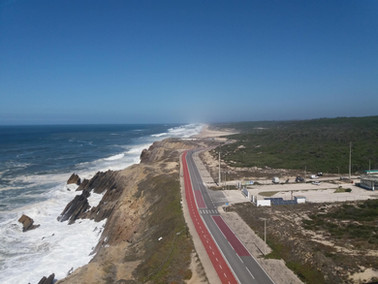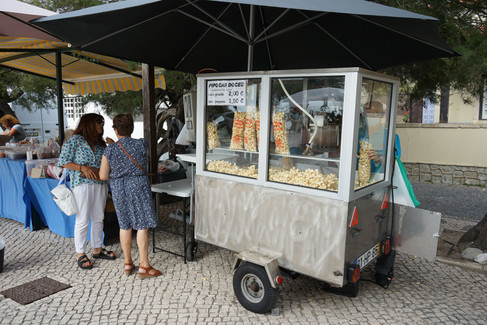Our insider guide to discovering São Pedro de Moel
- Portugal the Simple Life
- Jul 14, 2023
- 5 min read
Updated: Jul 17, 2023
From North to South, Portugal is rich in tiny villages that surprise us at every turn. São Pedro de Moel is one of those villages, with its breathtaking beach and picturesque homes nestled in a small cove in the heart of Pinhal de Leiria, Portugal’s most extensive pine forest.

Located just 19 km north of Nazaré, this quaint seafront village, with less than 400 residents, is considered one of the Silver Coast's most beautiful beaches.
From the royal pine forest to its noble origins
The pine forest surrounding São Pedro de Moel was planted by the order of Portuguese King Afonso III, in the 13th century.
Later, between 1279 and 1325, it was substantially increased by King D. Dinis I, known as the “o rei Lavrador” (the farmer king). It was during D. Dinis’ reign that the Leiria National Pine Forest, also known as “Mata Real” (royal forest) or “Mata do Rei” (the king’s forest), reached its current dimensions occupying an extensive area along the coast between the beaches starting at Pataias all the way north to the beaches of the municipality of Marinha Grande.

For centuries, this traditional seaside village was a popular beach destination for the Portuguese nobility and bourgeois to enjoy their summer holidays and weekend getaways.
Its noble origins date back to 1463, when the Portuguese king D. Afonso V donated São Pedro de Moel to the Count of Vila Real. This wealthy family owned several houses in the village, where they remained until 1641, when the last Marquis of Vila Real and his son, the Duke of Caminha, were executed.
São Pedro de Moel's elitist reputation dates back to this noble foundation and many of its most famous landmarks are still connected to members of the royal families who lived here in the past.
For example, the name "Penedo da Saudade" (which can be translated to “nostalgia rock”), on top of which lies São Pedro de Moel’s famous lighthouse, is a reference to the Duchess of Caminha, D. Joana Juliana Maria Máxima de Faro.

According to the legend of “Penedo da Saudade”, after the Duke was murdered because of his involvement in a conspiracy against the King of Portugal, the Duchess would visit this place every day, weeping in memory of her beloved. To this day, there are those who claim you can hear the young widow crying between the echoes of the sea beating on the rocks below.
💡Insider tip:
You can visit Penedo da Saudade lighthouse and climb all the way to the top of its tower, standing 32 meters high.
How to get there: 39.764208, -9.030906
The village’s romantic aura is also present in the history of one of its most famous residents: the poet Afonso Lopes Vieira, who moved to São Pedro de Moel in 1902 to live in a house previously owned by the Marquises of Vila Real.

The village inspired some of Vieira’s most beautiful poetry and today the poet’s home is a museum which you can also visit in the centre of the village: the Casa-Museu Afonso Lopes Vieira.
The poet’s house is one of the many in the village that features São Pedro de Moel’s traditional architecture. The beautiful holiday homes around the beach are famous for wooden shutters and railings, many of which adorn balconies that overlook the sea.
Getting lost in the idyllic streets around the centre of São Pedro de Moel is one of the many pleasures for those visiting the village!
An amazing lifestyle from January to December
Although São Pedro de Moel is well-known as a summer holiday destination, the locals flock to this amazing coastline all year round to appreciate the natural landscape and laid-back lifestyle.



During the summer, the village's main beach offers the perfect conditions to spend a day on the sand. Although the sea in São Pedro de Moel is sometimes cold and a bit rough, it is suitable for swimming. Other favourite activities include surfing and body-boarding.


For those who enjoy outdoor sports, there is also a tennis court and several bicycle paths. On the beach, there is also a playground, usually with volleyball nets.
To the north, following the wooden pathways that lead to the lighthouse, there are additional beaches which are smaller, but also beautiful, such as Praia da Concha.


Further north, you will find another amazing beach spot, with a more extensive sandy shore that you also access through a wooden walkway: Praia Velha.

When the weather is less inviting for a day on the beach, other favourite activities among the locals include queuing in line for Mr. Sabino’s famous popcorn at Praça Afonso Lopes Vieira. A tradition that has been in the making for more than three decades and is a mandatory stop on the weekends!
Mr. Sabino's famous popcorn is tasty and crunchy... Some swear it's the best they've ever tasted!
The perfect blend of sea and forest
For those who love cycling, the beautiful rugged cliffs north of São Pedro de Moel are framed by kilometres of trails along the coast.

💡Insider tip:
Along the shore, there are also several spots to sit back, relax and enjoy the view. Watching the sunset over the Atlantic is an experience not to be missed, so be sure to visit one of the many lookout points in São Pedro de Moel!

Miradouro de São de Moel: 39°45'17.2"N 9°01'51.8"W
São Pedro de Moel also has excellent conditions for hiking along the beach or in the nearby forest. Two famous footpaths include the "Volta dos Sete" and "Volta dos Cinco" pedestrian routes, which mix sea, pine forest and beach! The perfect setting to catch fresh air and discover several secluded natural springs, streams and creeks that seem to have stepped out of the pages of a fairy tale’s enchanted forest.

💡Insider tip:
Among the many beautiful places to visit in Pinhal de Leiria, the Tremelgo "giant" eucalyptus is one of the most amazing! This protected tree, over 160 years old, is one of the most famous in the King's Pine Forest and its biggest, measuring 48.5 meters high and 37.5 meters in diameter.
How to get there: 39° 44.220'N - 8° 58.038'W

However, it's in the most “secret” spots of São Pedro de Moel's forests that lies its true charm! Poets have tried to explain it, but you have to live it. Away from the main roads and wandering deep into the forest, the singing of the birds and the rustle of the wind among the pine trees will guide you in discovering how special this place is...
💡Insider tip:
Among the many secret places, one of our favourites is called "Vale dos Pirilampos" (valley of the fireflies). This isolated patch of forest, accessible only by footpaths, is simply beautiful, surrounded by gigantic trees and fallen trunks that blend into the landscape with the constant burbling of the stream nearby.
How to get there: 39° 45.399’N 8° 58.933’W
Other amazing spots include the Açude da Ribeira de São Pedro (which is more beautiful during the winter when the abundance of rain fills the dam), the ancient forest ranger houses and public fountains — two testaments of São Pedro de Moel's rich history — or the several picnic parks where you can spend quality time with friends and family surrounded by nature and fresh air!
And to top of the perfect experience, São Pedro de Moel also has several places to savour the Silver Coast’s freshest seafood and local delicacies. At Estrela do Mar restaurant, for example, you are spoiled with a fabulous view!
At the local “esplanadas”, enjoy a drink outdoors, sit back and relax while savouring a traditional Portuguese petisco such as clams à “bolhão pato”.



Don’t forget to subscribe to our newsletter to receive more blogs about Portugal!
Photos courtesy of Portugal Realty, real estate specialists on Portugal's Silver Coast. Visit the website to see property for sale near São Medro de Moel.
Portugal The Simple Life is sponsored by a network of Portuguese companies that specialise in supporting families transition to a simple life in Portugal. Please contact us if there is anything we can assist you with Leisure Launch Group, Immo Portugal, Portugal Accounting, Portugal Interiors, Portugal Realty, Presprop Portugal Construction, SCH Holiday Homes and SCH Property Management & Rentals.





















